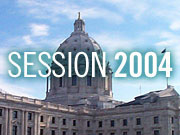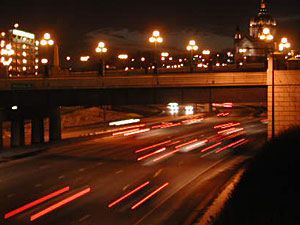Audio
Photos
Resources
Your Voice
| ||||||||||||||||||||||||||||||||||||||||||||||||||||||||||
Long-range transportation troubles loom for Twin Cities
April 4, 2004
The Metro Transit drivers strike has stranded thousands. However, experts say the problem pales compared to the transportation problems ahead. Advocates say the region's lack of transit isolates people without cars. Business leaders predict growing roadway congestion will stall the Twin Cities economy. A rising chorus of voices is clamoring for a comprehensive Twin Cities transportation plan to address the problems. But there's little agreement on what to build and how to pay for it.
St. Paul, Minn. — One way to understand the problems that lie ahead is to visit Martha Marlowe.
"I'm so used to just going out the door, getting the bus, taking care of what I have to take care of," she says.
 | |||
Martha Marlowe, 79, lives in south Minneapolis. She can recite from memory bus numbers and transfers she makes to visit her medical doctor downtown, her eye doctor in Edina and various other routes for myriad errands.
Marlowe no longer owns a car.
The Metro Transit drivers strike has brought her life mostly to a screeching halt.
"I take the buses everywhere. It's crippled me," she says.
Martha Marlowe and her aging cohorts put a face on one of the transportation challenges on the horizon. Figures from the latest census show they are one of the fastest growing demographic groups in the Twin Cities.
Elana Gravitz is the director of Nokomis Healthy Seniors, a small Minneapolis neighborhood non-profit that helps Marlowe and hundreds of other older residents stay in their homes by supplying services, including transportation.
 | |||
Gravitz says the bus strike has lit up her agency's lines with requests for transportation, and has revealed the growing number of people who rely on transit.
"I have to admit that I think I was assuming most of them were able to drive around at least the neighborhood during the day, and we've seen our requests double," Gravitz says.
Transit users are not a potent political force.
Business, on the other hand, carries much more clout.
Charlie Weaver is executive director of the Minnesota Business Partnership, one of the state's most powerful business interest groups. Weaver, a former Republican lawmaker from Anoka and former chief of staff to Gov. Tim Pawlenty, says the Twin Cities economy risks stalling out because congested roadways are delaying vehicles carrying goods and supplying services.
 | |||
"It's money wasted, jobs lost because of a transportation system that's becoming one of the most congested in the country," Weaver says.
Weaver and other business people want a better Twin Cities transportation system. There's growing agreement this means more buses, rail service and additional roadway lanes.
The cost? Unknown.
How much money is available? The Metropolitan Council estimates about $7 billion is available for Twin Cities road building over the next two decades from federal, state and local funding sources, and about $2 billion for transit.
However, billions more would be needed to fulfill the wish lists of all the interest groups. Even if the money were available, there's no consensus on what should be on the wish list and how to pay for the projects.
The Business Partnership's Charlie Weaver says the state gasoline tax is the fairest way to pay.
"The people who use it should pay for it, that's why the gas tax has always been the favorite of everyone for improving transportation," Weaver says. "Although this year you had for the first time, the House leader of the transportation committee talking about a business tax for transportation, which we hate."
A third suggestion is a metropolitan-wide sales tax dedicated to transportation projects.
Gasoline and sales taxes hit hardest at Martha Marlowe and others living on fixed incomes, at a time when she and other homeowners are getting socked with rising property taxes.
 | |||
Some of the sting of higher taxes will be offset because there'll be more people to share the burden, as many as one million more in the next 25 years.
However, many of the new Twin Cities residents are driving up the cost of a transportation system. They're moving to or beyond the edge of the Twin Cities, and building on larger lots.
We've sprawled into a region that's two-thirds the size of Chicago, with only one-third of that city's population.
The sprawl, John Adams says, started early. Adams, a University of Minnesota geographer and urban planning professor, says the trend began more than a century ago.
He says there are no canyons, oceans or mountains to contain Twin Cities development, just acres and acres of land suitable for building.
Adams says the earliest sprawl was aided by the Twin Cities' streetcar system built in the late 1800s, in anticipation of a population boom that didn't happen. The vast trolley system ended up serving lightly populated areas.
"That had the effect of opening lots of land for residential development. The price of land dropped fast. Land could be used extravagantly," Adams says. "Houses within walking distance of downtown Minneapolis could be built on 40-foot lots. At the very same time in Chicago, for instance, houses were built, three units on a 20 or 25-foot lot, because the land was three or four times as expensive."
The arrival of cars and cheap gasoline speeded up the decline of the streetcar era. Low-density development made the trolley system too expensive to operate.
Adams says the cost of future transportation needs could be lowered if we agree to rein in sprawl.
"Low-density development doesn't support high-capacity transit, unless there is local planning that is designed to steer development at higher densities in those areas that are served by transit," says Adams.
A handful of transit projects on the drawing boards may work like magnets to attract development and foster the higher population densities Adams encourages.
Lawmakers this session will likely approve a high-speed bus route to Burnsville and another to Anoka. Commuter rail advocates are optimistic Gov. Pawlenty's support will ensure continued development of the North Star line to Big Lake.
Counting on the gas tax to help fund transportation projects is a problem. It means either raising the tax or doing surgery on how the gas tax dollars are divided.
Gas tax revenue is roughly evenly divided between rural areas and the Twin Cities. The Business Partnership's Charlie Weaver says the metro area should get more because the needs are greater. That view is hotly disputed by rural lawmakers, who say outstate roads sustain the state's vital agriculture, mining and timber industries, among other activities.
Worry is one of the forces driving talk of a Twin Cities transportation plan. There's worry other metropolitan areas are making faster progress building transportation systems, and will edge out the Twin Cities as a good place to do business. Charlie Weaver says other cities have been able to build a consensus.
"If you look at Phoenix, or you look at Seattle, or you look Denver or you look at Boston -- they've all gotten together, and frankly it's mostly been led by the business community -- they've gotten together and said, 'We need a multifaceted approach to transportation,'" Weaver says. "What you're seeing in Minnesota is the business community has gotten tired of 10 or ... 15 years of haggling over this, and stepping up to the plate and saying, 'Let's see if we can pull together, see if we can get agreement and have a plan."
However, pulling together a plan and creating a political formula to pay for it is a tall order. If the current Metro Transit drivers strike is a guide, agreement on even the most basic issues will remain elusive.
|
News Headlines
|
Related Subjects
|


